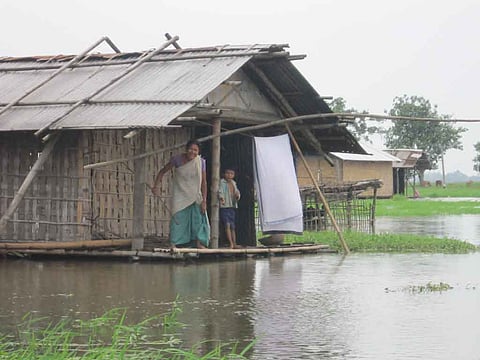
The climate change crisis is getting deeper. Every year the number of natural disasters like high-intensity storms and floods is increasing. The impact of these disasters is the most on the economically backward and marginalized people of the society. As per a United Nations study, caste-based discrimination affects more than 260 million Dalits around the world.
Dalits in South Asia make up the majority of victims facing this form of structural discrimination, which leads to marginalization, social and economic exclusion, and limited access to basic services, including water and sanitation.
Dalit families displaced by the 2020 floods in Bihar had to spend the nights in temporary tents despite the dangers of snakebite. After the severe floods in recent years, Dalit and tribal sanitation workers from across the country were engaged day and night to clear the flood debris.
Farmer Rakesh Kumar (45) owns 2 acres of land in the Karimganj district of Assam. He grows peppers and tomatoes relying solely on drilled wells without irrigation. Like him, marginalized communities are the most affected by climate change and frequent floods.
He is puzzled by the depletion of water from the well he dug on his land years ago. "When there is not enough water for the crops, I buy it from other farmers," he says sadly.
Among villages, 70% of SC and ST respondents said that total agricultural productivity has decreased in the last decade. One of the main reasons for this is the scarcity of water.
Rakesh said that "state or central government officials never help. Whenever I have water, pests attack my crop and I don't get enough tomatoes. If all goes well, I still don't get the right price."
The poorest are those who suffer the worst consequences of climate change, as they live in vulnerable areas and have fewer resources to adapt or recover quickly from shocks. As the effects of climate change worsen, escaping poverty becomes more difficult.
Dalit communities are more vulnerable to climate and natural disasters than other groups and are less likely to receive humanitarian aid. Laws designed to protect them are not enforced properly, and humanitarian agencies do not always understand the particularly vulnerable position of Dalit communities.
Kamla Devi, 54 resident of Karimganj district of Assam said that several people from her village have given up their main livelihood from farming due to a poor harvest and shortage of water as the heat wave is continually increasing. "The livelihood of people in the whole area depends on farming. But because the seasons (summer, monsoons and winters) have lost their balance and timing, farming has been severely affected due to floods, heatwave, short of water," said Devi.
Another villager, Dilip Kumar said, "The water table has dropped drastically and this has seriously affected the yield of our crops and forest products, adding that the weather pattern has affected them in general, women are suffering the most".
According to the National Campaign for Dalit Human Rights study, the impact of climate change on the lives and livelihoods of Dalits in India has increased in recent years. The mostly Adivasi and Dalit communities are the carriers of carbon pollution in eastern and central India with hardly any adaptation and mitigation strategies. The intensity of the impact of climate change on women within Dalit and Adivasi communities, landless or economically insecure groups, is deeper than on other privileged women.
Caste-based discrimination and severe water scarcity due to climate change plague Dalits every summer. Dalit women and girls sometimes travel long distances to fetch water, leading to incidents of physical and sexual violence. They are more vulnerable to implicit and explicit violence and occupy a very hopeless position in the social hierarchy.
Dalits are the worst victims of climate change in a developing country like India whose lives have already been affected by the effects of globalization, privatization and liberalization. Climate change is affecting India's economy, politics and society in deep and different ways.
According to some prominently published reports noted that "In more than 100 drought-affected villages in India, Dalit women are denied access to water sources in 48.4% of the villages. villages due to practices of segregation and untouchability. More than 20% of Dalits do not have access to safe drinking water."
The Dalit people are a highly vulnerable group, especially in the face of climate change, given both their high dependence on natural resources and the social, political and economic exclusion that inhibits their ability to adapt.
You can also join our WhatsApp group to get premium and selected news of The Mooknayak on WhatsApp. Click here to join the WhatsApp group.